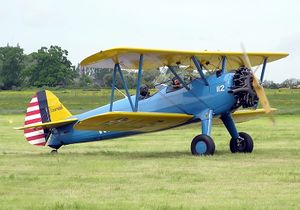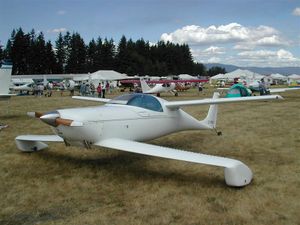PlaneSpottingWorld welcomes all new members! Please gives your ideas at the Terminal.
Biplane
A biplane is a fixed-wing aircraft with two main wings. The first powered heavier-than-air aircraft, the Wright brothers' Wright Flyer, used a biplane design, as did most airplanes in the early years of aviation. While a biplane wing structure has a structural advantage, it produces more drag than a similar monoplane wing. Improved structural techniques and materials, and the need for greater speed, effectively made the biplane configuration obsolete for most purposes by the late 1930s.
The term is also occasionally used in biology, to describe the wings of some flying animals.

Contents
Aviation
In a biplane aircraft, two wings are placed one above the other. Both provide a portion of the lift, although they are not able to produce twice as much lift as a single wing of similar planform. This is because a wing's effect is imposed on a circular cylinder of air as the craft moves forward. In the case of the biplane, the upper and the lower are are working on nearly the same portion of the atmosphere. In a wing of aspect ratio 6, and a wing separation distance of one chord length, the biplane configuration can produce about 20 percent more lift than a single wing of the same planform.[1]
In the biplane configuration, the lower wing is often attached to the fuselage, while the upper wing is raised above, although other combinations have occurred. Almost all biplanes also have a third horizontal surface, the tailplane, to control the pitch, or angle of attack of the aircraft (although there have been a few exceptions). Either or both of the main wings can support flaps or ailerons to assist lateral and speed control; usually the ailerons are mounted on the upper wing, and flaps (if used) on the lower wing. Often there is bracing between the upper and lower wings, in the form of wires (tension members) and slender struts (compression members) positioned symmetrically on either side of the fuselage.
Variations on the biplane include the sesquiplane, where one wing (usually the lower) is significantly smaller than the other, either in span, chord, or both. Sometimes the lower wing is only large enough to support the bracing struts for the upper wing. The name means "one-and-a-half wings".
Another (aerodynamically quite distinct) variation is the tandem wing which is an aircraft with one wing in front of the other (e.g. a wing in the nose and a wing in the tail). This is usually not considered a biplane, as the two planes are not near each other (relatively speaking).

Advantages and drawbacks to biplane designs
Aircraft built with two main wings (or three in a triplane) can usually lift up to 20% more than can a similarly sized monoplane of similar wingspan, which tends to afford greater maneuverability. The struts and wire bracing of a typical biplane form a box girder that permits a light but very strong wing structure.
On the other hand there are many disadvantages to the configuration. Each wing negatively interferes with the aerodynamics of the other. For a given wing area the biplane produces more drag and less lift than a monoplane, but this effect can be reduced by placing one wing forward of the other. Placing one wing forward of the other is known as stagger. Forward stagger (where the upper wing is further forward) is most common, but backward stagger has also been used, notably in the Beechcraft Staggerwing. Excessive amounts of stagger distort the box girder effect of the wing - and this tends to reduce the structural benefits of the biplane layout.
History
Most successful early aircraft were biplanes, in spite of considerable experimentation with monoplanes. For a period - (~ 1914 to 1925) almost all aircraft were biplanes. In retrospect, this seems strange, but the explanation is far from irrational.
In the early days of aviation all wing structures were strengthened by external bracing wires and struts. Effective lateral control (whether using wing warping or ailerons) requires a wing that is rigid enough to minimise unintended wing warping, and the unwanted lateral rolling that results. The structure of a biplane wing (having the characteristics of a box girder) provided this almost by default, whereas the design of a sufficiently rigid ‘’externally braced’’ monoplane wing was highly problematic.
The long-term answer to the problem was a cantilever wing – having sufficient stiffness to dispense with external bracing. Such wings were already being designed and used in Germany during the last year of the First World War; and following research in the post war years by the National Advisory Committee for Aeronautics and similar European bodies, as well as the concurrent development of aluminum alloys, cantilever monoplane wings were becoming the norm for most applications by the early nineteen thirties; and the era of the biplane was almost over.
Modern biplane designs now exist only in specialist niche roles and markets such as aerobatics and agricultural aircraft.
The vast majority of biplane designs have been fitted with reciprocating engines of comparatively low power; exceptions include the Antonov An-3 and WSK-Mielec M-15 Belphegor, fitted with turboprop and turbofan engines, respectively. Some older biplane designs, such as the Grumman Ag Cat and the aforementioned An-2 (in the form of the An-3) are available in upgraded versions with turboprop engines.
Famous biplanes include the Sopwith Camel, Avro Tutor, Antonov An-2, Beechcraft Staggerwing, Boeing Stearman, Bristol Bulldog, Curtiss JN-4, de Havilland Tiger Moth, Fairey Swordfish, Hawker Hart, Pitts Special and the Wright Flyer. The Stearman is particularly associated with stunt flying with wing-walkers. Famous sesquiplanes include the Nieuport 17 and Albatros D.III.
The biplane in hang gliding
- Hang Glider 1920s.jpg
Biplane hang glider under tow. Philadelphia, USA, 1920s.
- Spratt-glider.jpg
Dr. George A. Spratt. USA, 1929.
Octave Chanute biplane. The Otto Lilienthal biplane hang glider. The 1910 Boy Mechanic Biplane Hang Glider. Charles Hampson Grant built and flew a biplane hang glider in 1910 or 1911. The 1922 biplane hang glider flown in sport gliding competition. Waldo Waterman biplane hang glider. The George A. Spratt biplane hang glider may have been the first hang glider to use the pendulum weight-shift of pilot in combination with a cable-braced triangle control bar or A-frame control bar that was later used variously braced in other hang gliders by Barry Hill Palmer of USA and then later by Mike Burns of Australia; and then again cable braced in some Rogallo delta ski-kites and Rogallo hang gliders. The Hang Loose biplane hang glider by Jack Lambie. The best decorated biplane hang glider of the May 23, 1971, Otto Lilienthal Birthday Party hang glider meetting was crafted and flown by Larry Dighera certificate. Bean's Bird biplane hang glider was designed and built by Art Bean of Southern California; he won the Biplane Best Craftsmanship award at the May 23, 1971, Otto Lilienthal Birthday Party hang glider meeting, awarded by Self-Soar Association and announced in Low & Slow; a trophy from Joe Greblo of Windsports company was given to Art Bean for Bean's achievements. Taras Kiceniuk's Icarus I tail-less biplane hang glider was folded in a test flight by Joe Faust; the design was quickly built into the next version: Icarus II tail-less biplane hang glider. Kiceniuk Icarus II was the stronger version. Seagull-Waterman biplane hang glider was supervised in its construction by the original designer Waldo Waterman. Christopher Talbott-Jones of Southern California, USA, in early 1970s built and flew a tail-less biplane hang glider; his son became interested in hang gliding also; a photograph in a Santa Monica, CA newspaper shows Joe Faust flying the biplane tail-less hang glider off a 5 ft. sand dune at Venice Beach, CA. Do not confuse the distinct persons of similar names. Another tail-less biplane was flown by pilot Christopher Hornzee-Jones and is featured at Aerotrope. Christopher Hornzee-Jones, the founder and director of Aerotrope, founded in 2005 in Brighton, UK. Larry Mauro first built a tail-less biplane hang glider; then he added an engine, producing a power-assisted foot-launch aircraft, Easy Riser.
The biplane in ultralight aircraft
Larry Mauro created the Easy Riser biplane ultralight. Mauro also made a version powered with solar cells driving an electric motor for successful flight. Mauro's Easy Riser was used by the man who became known as "Father Goose", Bill Lishman.[2]
The biplane in avian evolution
It has been suggested the feathered dinosaur Microraptor glided, and perhaps even flew, on four wings which were held in a biplane-like arrangement. This was made possible by the presence of flight feathers on both the forelimbs and hindlimbs of Microraptor, and it has been suggested the earliest flying ancestors of birds may have possessed this morphology, with the monoplane arrangement of modern birds evolving later.[3]
See also
References
- ↑ Airplane Aerodynamics, Dommasch and Lomb, 1961 ed.
- ↑ Larry Mauro and Bill Lishman
- ↑ Chatterjee S, Templin RJ (Jan 2007). "Biplane wing planform and flight performance of the feathered dinosaur Microraptor gui". Proc Natl Acad Sci U S A 104 (5): 1576-80. PMID 17242354.
External links
- Historical Collection o Biplane Pictures
- Jacqui Hayes: Bird wings evolved from biplane dinosaurs COSMOS magazine THE ULtimate magazine
- Octava Chanute biplane hang glider: Chanute
Lists relating to aviation | |
|---|---|
| General | Timeline of aviation · Aircraft · Aircraft manufacturers · Aircraft engines · Aircraft engine manufacturers · Airports · Airlines |
| Military | Air forces · Aircraft weapons · Missiles · Unmanned aerial vehicles (UAVs) · Experimental aircraft |
| Notable incidents and accidents | Military aviation · Airliners · General aviation · Famous aviation-related deaths |
| Records | Flight airspeed record · Flight distance record · Flight altitude record · Flight endurance record · Most produced aircraft |
bg:Биплан cs:Dvouplošník da:Biplan de:Doppeldecker (Flugzeug) es:Biplano eo:Biplano fr:Biplan id:Pesawat bersayap ganda it:Biplano he:מטוס דו כנפי lt:Dvisparnis lėktuvas nl:Dubbeldekker (vliegtuig) ja:複葉機 no:Biplan pl:Dwupłat pt:Biplano ru:Биплан sl:Dvokrilnik sv:Biplan uk:Біплан
| This article is licensed under the GNU Free Documentation License. It uses material from the Wikipedia article "Biplane". |

